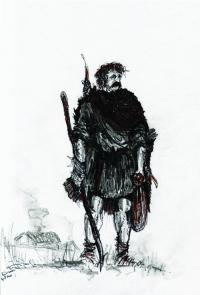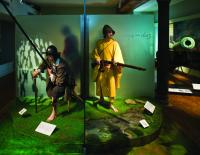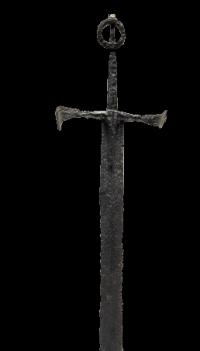‘Hags of hell’:late medieval Irish kern
Published in Features, Gaelic Ireland, Issue 1 (Jan/Feb 2011), Medieval History (pre-1500), Volume 19
‘Shag-hair’d crafty kern’—this reconstruction represents the basic foot-soldier, armed in a homespun manner, that an Irish chief could field in a ‘rising out’.
There is a moment in the second part of Shakespeare’s Henry VI when Cardinal Beaufort warns that:
‘The uncivil kerns of Ireland are in arms
And temper clay with blood of Englishmen:
To Ireland will you lead a band of men,
Collected choicely, from each county some,
And try your hap against the Irishmen?’
More a force of nature than a professional soldier, by Shakespeare’s time the ‘shag-hair’d crafty kern’ had mushroomed in the English popular imagination to become a figure of hate, a semi-mythic bogeyman lurking in the woods. From the point of view of an Irish lord, kern were a means to wage war, a means to overawe, a means to survive. Yet historians have paid them only passing attention.The word ‘kern’ is a phonetic rendering in English of the Irish ceithearn, meaning in a general sense a ‘war-band’ or ‘troop’ and having its roots in words signifying ‘battle’ and ‘slaughter’. From ceithearn we get ceithearnach for ‘trooper’. The ceithearnach was, however, understood to be a specific type of Irish soldier—he was the light infantryman of Gaelic Ireland, distinguished by his equipment and manner of fighting from the country’s two other major troop types, the galloglass and the horseman.
Even a colonial administrator as hostile to the Irish way of life as Edmund Spenser could admire the stoical resilience of Irish kern, hailing them as ‘great endurers of cold, labour, hunger, and all hardness’, and ‘very great scorners of death’. (Drawing by F. Cannan and Pembroke College, Cambridge)

Even a colonial administrator as hostile to the Irish way of life as Edmund Spenser could admire the stoical resilience of Irish kern, hailing them as ‘great endurers of cold, labour, hunger, and all hardness’, and ‘very great scorners of death’. (Drawing by F. Cannan and Pembroke College, Cambridge)
Recruitment
To Barnaby Rich (1542–1619), an outrageously cantankerous English soldier-writer who survived many a brush in Ireland, kern were nothing more than ‘the very dross and scum of the Country . . . the very Hags of Hell, fit for nothing but for the gallows’. Robert Payne, an Elizabethan settler in Munster, saw kern simply as ‘warlike men’: there can be no better summary of kern than that. Hardy and swift-footed, the common kern was a pugnacious survivor who had learned his craft the hard way from cattle raids and incessant blood feuds. Above all else, the kern, as an idea and a class of warrior, was wholeheartedly Gaelic and wholeheartedly rural, leading the Glossographia of Thomas Blount to note, somewhat contemptuously, in 1656: ‘We take a Kern most commonly for a Farmer or Country Bumpkin’.
Rich, though conceding that he was ‘better practised in my pike than in my pen’, was emphatic that Ireland was a static society ordered by arcane customs, a land where ‘if the father hath been a Kern, the son will be a Kern’. But while kern might seem ‘scum’ to Rich, the reality was that most belonged to a fairly privileged section of Irish society formed of free farmers, lesser tenants and younger and bastard sons of noblemen—a sort of Hibernian yeomanry analogous to that much-feared and peculiarly classless class of Highland Scot, the so-called ‘caterans’. Bearing arms was itself a proof of status and most kern would have felt themselves to be men of a certain social consequence, even if not always easily definable or apparent to outsiders, a point illustrated by the wonderfully confused pardon from Henry VIII to one ‘Peter Walshe, of Derconnor, gent., otherwise called Peter Walshe, of Arnemellan, yeoman, otherwise Peter Walsche, of Unane, horseman or kern’.
Within the broad category of ‘kern’ there existed two sub-types: one was a wandering mercenary or buanna employed for a few months at a time; the other was a peasant clansman fighting for a single lord in the ‘rising out’ (gairmsluaigh) or general muster of his people. The ‘rising out’ included all men fit to bear arms, save for the learned professionals of the clan (clergy, bards and so on). Pledges of loyalty, feudal or tribal dues, and networks of extended family were not a terribly efficient means of raising an army, and professional—and more dependable—mercenary kern became an important component of Irish military organisation. As well as fielding hordes of part-time kern levied in the rising out, Irish chiefs would often retain a selection of ceithearn tigh or ‘household kern’, who together with the galloglass and ‘lord’s galloglass’ (personal champion) formed a kind of praetorian guard, warding against both foreign foes and internal intrigue.
An Irish kern from the 1590s as depicted in the ‘Soldiers and Chiefs’ exhibition in the National Museum, Collins Barracks. Note the saffron-coloured tunic typical of the period, the contemporary ‘Cabasset’-style helmet and the musket. Whenever possible, Irish kern equipped themselves with the latest arms and armour, whether imported, stolen or made by local smiths. (National Museum of Ireland)

An Irish kern from the 1590s as depicted in the ‘Soldiers and Chiefs’ exhibition in the National Museum, Collins Barracks. Note the saffron-coloured tunic typical of the period, the contemporary ‘Cabasset’-style helmet and the musket. Whenever possible, Irish kern equipped themselves with the latest arms and armour, whether imported, stolen or made by local smiths. (National Museum of Ireland)
Cutting English throats: military training
The sense is inescapable—though it may be an affront to the bookish sensibilities of modern armchair generals and academics—that ordinary life in medieval Ireland (and England!) was frequently so anarchic and awful that the average kern must have been hardened to the point of indestructibility long before he first picked up a sword as a soldier. Away from the towns, raids by brigands and soldiers were common, little law and order existed, and men would have learned from boyhood to be always on their guard. A glimpse of hunted, desperate lives is preserved in the English use of the word ‘kern’, a term which came to mean not only a light skirmisher but a brutal vagabond, a rowdy hillbilly, a bog-dwelling savage (or ‘an Irish boor’ according to one eighteenth-century dictionary). But even a poet and colonial administrator as hostile to the Irish way of life as Edmund Spenser (c. 1552–99) could admire the stoical resilience of Irish soldiers, hailing them as ‘great endurers of cold, labour, hunger, and all hardness’, and ‘very great scorners of death’. These are not attributes that are easily taught on a parade ground. They must be acquired first-hand through cold, hard experience.
We know from a Tudor government report that formal military training was provided to Irish boys from the age of sixteen, probably by family members and foster relatives. ‘On-the-job’ training was available too, the same report noting that every two kern had a ‘lad’ to ‘bear their gear’. So, like galloglass, kern were accompanied by young attendants, possibly squire-like apprentices learning their craft from experienced warriors. Spenser, furthermore, claimed that it was common for kern to have been grooms or horse boys in their youth, often to English gentlemen. Spenser reckoned this a ‘foul oversight’, since the young Irish grooms learned many useful skills from their English masters, making them all the more proficient at cutting English throats when they grew up to become kern.
Sixteenth-century Irish sword found in Lough Neagh. (National Museums, Northern Ireland)

Sixteenth-century Irish sword found in Lough Neagh. (National Museums, Northern Ireland)
‘Darts and skeanes’: weapons and armour
John Dymmok, who served in the retinue of the earl of Essex, Elizabeth I’s lord lieutenant of Ireland, provides the classic description of a kern equipped for war:
‘. . . a kind of footman, slightly armed with a sword, a target [round shield] of wood, or a bow and sheaf of arrows with barbed heads, or else three darts, which they cast with a wonderful facility and nearness, a weapon more noisome to the enemy, especially horsemen, than it is deadly’.
Dymmok’s description is certainly sound: for centuries the kern was a lightly armed foot-soldier fighting with sword (cloidhem), long dagger (scian), bow (boga) and set of javelins or ‘darts’ (ga). Gerald of Wales (c. 1146–c. 1223) speaks of the Irish going into battle without armour, carrying short spears, axes and ‘darts’; much later, the Britannia of William Camden (1551–1623) presented kern as ‘light armed footmen . . . whose service is with darts and skeanes’. Kern did not, of course, go into battle naked. For a start, a loose tunic, often saffron-coloured during the Tudor period, was typically worn, sometimes with a short coat. For warmth, a kern wrapped himself in a shaggy cloak or brat. We know that kern used shields; pictorial sources suggest, too, an occasional use of helmets and gauntlets, and Jean Froissart (c. 1337–c. 1410) includes a description of the Irish wearing ‘very simple’ armour (perhaps leather or fabric forms of protection). But to an English man-at-arms encased in iron plate this lack—or very minimal use—of metal armour would have amounted to ‘nakedness’.
Irish military design was anything but static; whenever possible, Irish warriors equipped themselves with the latest arms, whether imported, stolen or made by local smiths. From the sixteenth century kern used guns with a skill and enthusiasm for all things new and military, though the bow—a shorter weapon than the awesome English longbow—continued to prove its worth for a long time after. Nevertheless, despite the fact that the kern was a troop type that was forever developing, the basic ‘look’ and fighting ethos of the kern remained essentially unaltered for centuries. It remained so because it worked.
Rather than bodily defence, ‘skipping kerns’ (Shakespeare, Macbeth) relied on speed and surprise to see them through. When it came to battle, kern would make a sudden rush on the enemy, bellowing war cries, pipes blaring, pitching their darts, before setting to work with broad-edged sword and dirk. If the enemy held his ground, the kern’s effectiveness was liable to wane. Principally irregular skirmishers rather than field infantrymen, kern had limited staying power in the face of missile fire or sustained assault. For this reason it was, says Camden’s Britannia, the heavily armed, axe-wielding galloglass who were commonly ‘set in the rearguard’, providing much-needed ballast to the darting waves of kern and horsemen. But when it came to ambushes, raiding, reconnaissance work and the murky, scrappy techniques of inter-clan warfare, the ceithearnach was absolutely first-rate.
‘Now rebels’
The English were not slow to recognise the kern’s skill as a scout and his potential as a counter-insurgency specialist. As expert guerrilla fighters, kern were precisely what the English needed, paradoxically, to pacify Ireland (see sidebar on ‘the Keating kern’). The alliance between Crown and kern did not last. When revolt swept Ireland in the late sixteenth century, Keatings were among the insurgents, a report of the period describing the ‘Ketings’ Kerne’ as ‘ill disposed, and now rebels’. Besides, something dramatic had happened to the kern: Hugh O’Neill, earl of Tyrone, had turned them into a modern force of pike, musket and ‘targeteers’ (swordsmen used to exploit gaps in the enemy’s lines). For a while these reforms seemed to yield miracles. At the Yellow Ford in 1598 Irish resistors went head to head with a powerful English force and won. It was a stunning moment in Irish military history. But the victory proved temporary and the world of the ‘rough rug-headed kerns’ (Shakespeare, Richard II) came tumbling down. And yet, even as the galloglass as a fighting class receded into the historical past, kern remained the muscle behind every fresh rebellion, still proving, as the adventurous Thomas Gainsford put it in 1618, ‘sufficient souldiers, but excellent for skirmish’. In the 1600s, it was a dubious honour. HI
Fergus Cannan is Associate Curator of ‘Object of Devotion: Medieval English Alabaster Sculpture from the Victoria and Albert Museum’, currently touring the United States.
Further reading:
F. Cannan, Galloglass, 1250–1600 (Oxford, 2010).
J. Derricke, The image of Ireland (ed. D.B. Quinn) (Belfast, 1985).
K. Simms, ‘Gaelic warfare in the Middle Ages’, in T. Bartlett and K. Jeffrey (eds), A military history of Ireland (Cambridge, 1996), 99–115.
















